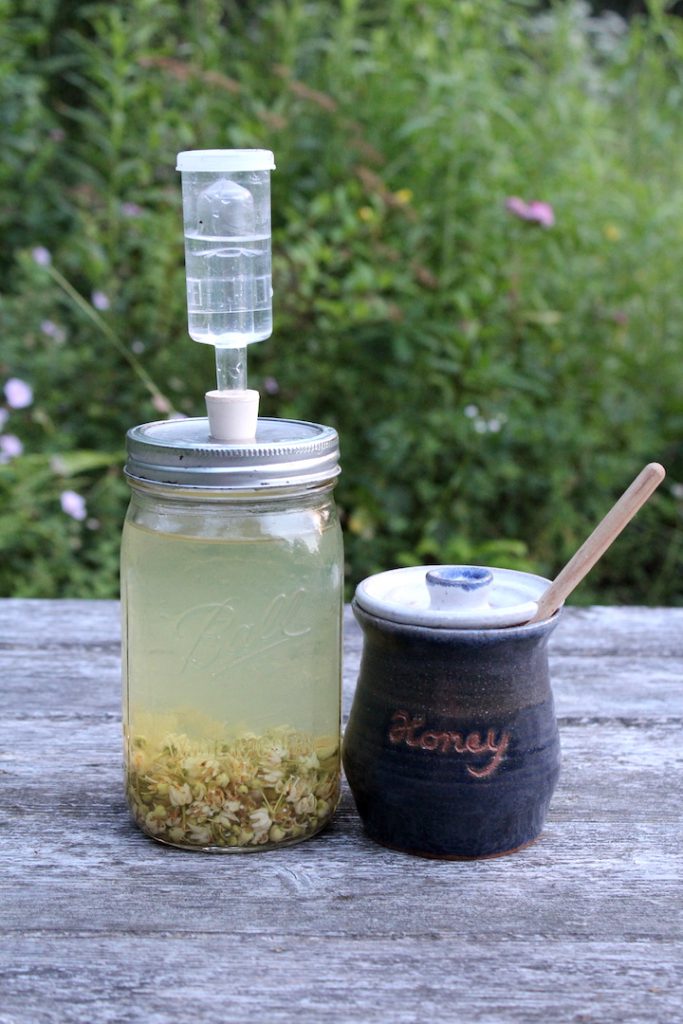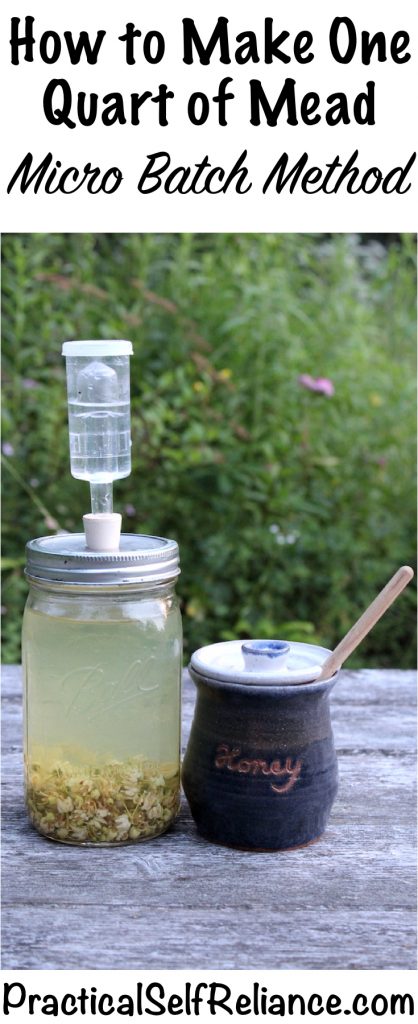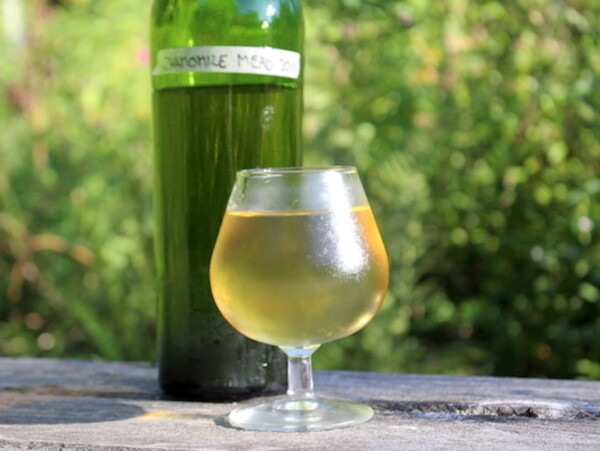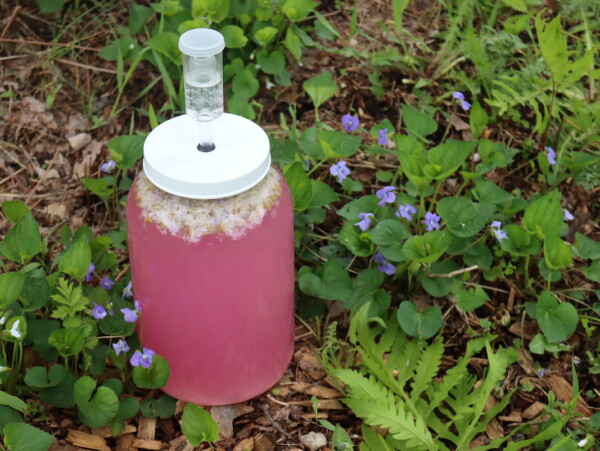Affiliate disclosure: This post may contain affiliate links. Please see our Privacy Policy.
There are a lot of great reasons to make a micro-batch mead. A super tiny batch is a great place to start if you’re just learning the process of mead making or if you’re an experienced brewer but you’re trying out something experimental.
Medicinal brews, using medicinal herbs, are also a great match for micro-batches because more often than not you’re taking smaller doses and don’t need a whole gallon, let alone 5 gallons.
I’m going to walk you through the basics of making a one-quart batch of plain mead. If you’re a beginner without a lot of equipment, give it a try.
For the rest of you interested in micro-batches, this is a good jumping-off point, and this recipe can be adapted based on your own creativity.
Want to add herbs? Or fruit? Or cider? Or just go crazy and toss in hot peppers and mustard seed? Go for it.
My goal here is to give you the basics of super tiny batches so that you have a foundation for your own experimentation.

Equipment for Micro Batch Mead
To get started, all you really need is a single-quart mason jar and a mason jar fermentation kit. Most mason jar fermentation kits are used with lacto-fermented veggies, but mead, wine, home brew and cider use the same principle.
The idea is to let gasses escape so that the container doesn’t explode as your little microbes put off CO2, but at the same time prevent air and spoiling bacteria to enter. They’re simply made one-way valves.
If you really want to go cheap, you don’t even need a home fermentation kit. I’ve seen tiny batches made in a discarded soda bottle with a balloon stretched over the top.
The balloon expands to allow the gasses space but seals it off to outside air. A simple plastic bag held on with a rubber band is also a common hacked-together alternative.
All manner of things can be used as an airlock, but really, if you’re planning on doing this more than once, invest in a fermentation kit. Honey is relatively expensive, so your ingredients are going to set you back more than the basic equipment.
There are a number of brands to choose from. I use one by Fermentools that looks a lot like a home brew setup, and if you choose to do bigger batches later you’ll need the rubber stopper and water lock that are included in the kit. I’m hoping at some point to try out these silicone fermentation lids from Mason Tops because they look super easy to clean.
Honey Ratios for Micro Batches
A one-gallon batch of mead generally uses 2 to 3 pounds of honey. Personally, I find 3 pounds of honey to a gallon to be way too sweet unless you’re adding in something tart to balance it.
Three pounds to a gallon works great for something like blackcurrant mead, where the fruit is quite tart and astringent. For something like raspberry mead, the result is a bit cloying. Adjust to your own tastes, but keep in mind that the 3 pounds to 1-gallon ratio will give you a dessert mead.
Three pounds to one gallon is, however, a convenient ratio for converting a recipe from a one-gallon batch to a one-quart batch. One pound of honey is 1 and 1/3 cups, so three pounds of honey would be 4 cups of honey.
A quart batch is 1/4 the size of a gallon batch, meaning that if you’re making a sweet mead, you’d start with 1 cup of honey for your quart batch of mead.
For a drier mead, the recommendation is 2 pounds to a gallon instead of 3 pounds. For a quart batch, that means you’d want 2/3 of a cup for a drier mead. Anywhere between 2/3 of a cup and 1 full cup will work just fine.
Choosing Yeast for Micro Batches
Yeast is a bit trickier. Sure, you could toss in a pinch of bread yeast, and it will in fact make alcohol, but it won’t taste particularly good.
Different yeasts impart different character to your batches. A good place to start is with a champagne yeast because it will allow your brew to reach a respectable alcohol percentage without being too picky. It also doesn’t put out any off-flavors.
Dry brewing yeast packets are packed for 5-gallon batches, so they’re already overkill if you’re making a 1-gallon batch, and they’re downright preposterous in a 1-quart batch. I start with a small packet, and eyeball measure about a quarter of it to rehydrate in 1/4 cup of water. The rest, I save inside the packet in a ziploc bag in the fridge until I’m ready to make my next batch.
It’s important to rehydrate dry yeast before exposing it to a high sugar environment so that the yeast cells don’t go crazy too fast. Putting them into the honey water before they’re rehydrated can potentially kill or stunt them. Be sure to rehydrate the yeast in a small amount of water, for a quart I use about a 1/4 cup.
Liquid yeasts are also an option, and White Labs makes glass vials of a variety of specialized yeast strains. If you’re going to make hard cider, or a cizer (mead/cider mix) then give their liquid cider yeast a try. Again, I’d just use a part of the vial in a quart-sized batch.
How to Make a Quart Batch of Mead
With your super basic equipment and ingredients in hand, you’re ready to get started!
I make my batches as lazy as possible, producing as few dishes as possible. It makes it easy to brew in a tiny kitchen and helps prevent you from getting overwhelmed by equipment, mess and dishes that are a problem in larger-scale home brew.
Start by adding 2/3 to 1 cup of honey directly into the bottom of a quart mason jar. Bring some clean, chlorine-free water to a boil in a tea kettle. Let it cool a little, and then pour hot, nearly boiling water into the jar until it’s about 3/4 of the way full. Stir until the honey is completely dissolved.
Allow the honey and water mixture to cool to around body temperature, somewhere between 90 and 100 degrees. Pitch in your already dissolved yeast, and then top with more water until you’re about 1 inch from the top of the jar. Add on your mason jar fermentation kit and let your brew ferment at room temperature out of direct sunlight for 4-6 weeks.
Primary and Secondary Fermentation
Often homebrewers talk about “primary” and “secondary” fermentation, and as you’re watching your mead bubble away in the jar you’ll be able to see the difference. During primary fermentation, the bubbling is very vigorous as the yeast are feasting on large amounts of sugar. It’ll take a day or two to get going, but after that, for the first 1-2 weeks, there should be very active primary fermentation.
After the primary ferment, when the yeast settles down a bit, most brewers will pour off the brew into a clean container, leaving the sediment behind. This results in a clearer final brew and can improve quality.
It’s optional but highly recommended in a few cases. If you’re using fruit chunks or whole spices, I’d suggest you “rack” the mead over into a clean container after primary and filter out any solid spices or fruit through a fine-mesh strainer.
Big fruit chunks floating above the water level in the container can mold over time, and spices like cinnamon can add harsh flavors if left in too long.
If you choose to move or “rack” the mead into a secondary container, just choose another clean quart mason jar and after you’ve carefully poured the mead over, leaving sediment behind and filtering out solids, attach the water lock to the top of the new jar and allow it to finish fermenting until it’s time to bottle.
Bottling Small Batch Mead
To bottle, for larger batches you siphon the brew over to another container, leaving the dregs at the bottom so they don’t give any off-flavors to your brew. In a quart jar, I’ve been very successful just very carefully and slowly pouring the mead off into a separate jar before bottling, leaving the sediment behind. This saves both the cost of a siphon setup, along with the mess.
To bottle, you can either just cap it up in the clean mason jar you racked the mead into. Better yet, I’ve been using these grolsch bottles. The cap is integrated into the bottle, which saves you on buying a bottle capper and it’s much easier than corks.
Depending on the type of mead, it may taste pretty decent at this point, or horrible. Some of the best meads taste a bit raw at this point, but they just need time.
If it tastes like vinegar, then something went wrong, likely with your airlock. Use it as a honey vinegar on salads and try again.
Just about every type of mead tastes better after some time in the bottle. At least 2 weeks, but preferably much longer. Fruit meads mature faster, more delicate floral meads or any type of spiced mead needs more time.
The nice thing about bottling in a Grolsch bottle or right in a mason jar is that you can take a nip, test it, and then cap it back up. That’s not an option with a cork.
Notes on Making Better Mead
A few notes…this will in fact make a mead. All you really need is honey, water and yeast. With that in mind, honey is a complex food that’s much harder to digest than beer malt or grape juice.
Most mead makers help the yeast out a bit by adding a bit of other nutrients to give them a boost. A good cheap way to do that is to add a few raisins to a batch. Two to three is plenty for a quart batch.
For flavor, adding in a bit of tannin and acid is also a good idea. A slice of lemon or orange, skin and all, adds in a little acid and bitterness from the pith in the peel, along with some delightful citrus notes.
Some brewers put a black tea bag in with their brew for tannin, but that’s overkill for a micro-batch. If you’d like to try it, make a very weak cup of tea, steep black tea in 1 cup of water for 30 seconds to a minute, and try adding that in as part of your water.
Experimenting with Micro Batch Meads
If you’re making an experimental batch, try adding in 1/4 to 1/2 cup of fruit, a few tablespoons of herbs or switch out your water for cider, juice or tea. I’ve enjoyed all manner of mead, from hot pepper to tomato, and they’re all pretty darn good.
Be careful using anything that’s going to dramatically change the chemistry of the brew. Lots of lemon or lime juice, for example, will add a lot of acid that can be harsh on the yeast (and your palate).
Overall, have fun, and the sky’s the limit! You’re making a small batch to learn and to try new flavors, so there’s little risk in time, equipment, mess or ingredients with this method.
What micro brew meads are you excited to try first? Leave a note in the comments.















Hi again! Also meant to ask, do you have any idea of the alcohol content in this small batch mead? I’d love to make one with 7% or under, so less than the usual 12-13% in store bought wine.
Thank you!
The finished alcohol content depends on the alcohol tolerance of your yeast. If you choose a cider yeast, they usually have an alcohol tolerance of around 5 to 8%. Just about any wine yeast is going to get you to 12% or more. You can also control it a bit with temperature and sulfites. If you’re targeting 7%, I’d use about 3/4 as much sugar, ferment it at around 50-60 degrees F to slow things down, and then when it’s at about where you want it (just barely still sweet, so not quite all the sugar has converted to alcohol), add a bit potassium metabisulfite to sterilize things and kill off the yeast. I don’t do any of these things personally, because I’m fine with normal wine alcohol levels, so I’m not speaking from experience here, just theory. Best of luck!
Hi Ashley! Thank you for this article, I’m excited to try mead making! A few questions after reading your article and instructions:
1. If I want to make the small quart batch and add an herb such as fresh lemon balm, is the few Tbsps amount you mentioned for the qt size batch or for the larger batch?
2. Do you add the herbs and/or fruit to the first ferment and then strain everything out for the second ferment?
3. If I add an herb to the batch can I still add a slice of lemon or orange or should you only do one or the other.
4. You linked the Mason tops Pickle Pipes – Airlock Fermentation Lids as possibly working well and I’m inclined to order these, as they seem simpler to me. Do you know yet if they actually work as well as the others? https://www.amazon.com/gp/product/B01LWS63OF/ref=ox_sc_act_title_2?smid=A30XMZD2MJMP62&psc=1
5. Is there another reason to heat the water before pouring it over the honey, other than to dissolve the honey? I’m wondering if you can you just warm it enough to dissolve the honey but not get it hot enough to kill the beneficial enzymes in the raw honey?
Thank you for the great article and for your help!
Great questions!
For the herb quantities, you’d want to use about as much as you’d use for making a tea of that herb. That can vary dramatically by herb, but for lemon balm, it’d be a few TBSP dried for a quart. Add them into the primary ferment and then strain out before secondary. The lemon/orange is to add acidicy, and you still want that even if you add herbs. You can also use a bit of lemon or orange juice to make sure the mix gets acidic, which helps the yeast ferment properly. The mason tops pickle pipes are the best! THey’re all I use these days and I need to update the article. They’re so much more convenient and work really well. For the heat, some people like to sterilize the honey because it contains yeast, and they like to kill that all off to ensure it’s just the wine yeast strain in the ferment. Personally, I usually just warm the water enough to dissolve the honey, around 100 degrees F or so. The boiling isn’t strictly required, and I like to keep the honey raw too. Enjoy!
Hey love, I just wanted to let you know your affiliate link for the fermentation lid is no longer a valid link as the product is no longer available. Didn’t know if it was possible for you to change up the link. I’m super excited to try this though so thank you for all the information! My family is also hoping to be able to do an off grid homestead in the near future too!
Thank you so much for letting us know. If you click on the link and then search for a different fermentation lid, it should still work for you.
Thank you so much for this article! My first husband and I used to brew in 5-gallon batches, but that was 40 years ago. Like others have stated, I don’t have the capability of making and storing that much at one time. I can do this easily! I am looking forward to picking up some apricots this summer, some pomegranates this fall, and who knows what else in between. My first batch may be pure honey, but I might go crazy and add some tea.
You’re very welcome. We can’t wait to hear what you come up with.
Hi! I’m wondering if I could make this using raw honey, a hibiscus tea (or some other tea) in place of plain spring water, and that is it? No added yeast as the raw honey will have that? Or perhaps add some dehydrated orange or grapefruit rinds? How would a dehydrated rind affect the outcome of the taste? I’m loving all of your articles and am feeling inspired to get creative with some mason jars I have available!
Yes you could definitely do that. Experimenting is a great idea. Let us know if you decide to give it a try.
Hi there! I know you made this post years ago but I loved it and found it very informative! Is it absolutely necessary to use honey as the base, or could I make a simple syrup and use that? Just asking becuase simple syrup hold so much flavor I’d love to try it with lavender or citrus syrup. Thank you!
This is a mead which always uses honey. That’s what makes it a mead. You can definitely use the citrus or lavender and make a wine. We have lots of recipes for that on the website as well.
Hello! I started this 2 weeks ago, using raw honey and champagne yeast, no additives, and still haven’t seen any activity. My house ranges from 65-69 degrees. Any idea why not? Any suggestions to save it?
Did you allow the mixture to cool before adding the yeast and did you dissolve the yeast before adding it to the mixture?
Yes and yes. Sorry for the delay on my response. In that time there was still no sign of activity except for occasional condensation in the airlock. But no bubbles, water in airlock not moving back and forth. Maybe a bit of foam on the surface of the mixture but not really bubbles, more scummy looking.
The foam could be an indicator of some activity. What is the temperature?
Ranges from 66-68 most days, occasionally as high as 70
Warmer temperatures will definitely give you more activity.
I have some dried linden flowers from earlier this spring. I think I will add some of those… Or do the herbs have to be fresh?? I was thinking maybe some dried chamomile flowers, dried linden flowers, and some apple slices… Maybe an orange slice as well. I figured it would be nice to have a small glass in the evening…
Thanks so much for writing an article on small batch! Honey isn’t cheap nowadays, and I was a little afraid of wasting… I like the idea that if it turns into vinegar I can use it another way though 😁
Yes, you can totally use fresh or dried herbs.